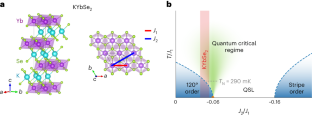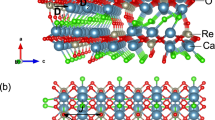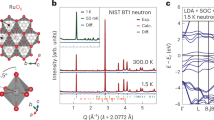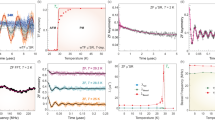Abstract
The Heisenberg triangular-lattice quantum spin liquid and its phase transitions to nearby magnetic orders have received much theoretical attention, but clear experimental manifestations of these states are rare. Here we demonstrate that a spin-half delafossite material, namely, KYbSe2, shows close proximity to the triangular-lattice Heisenberg quantum spin liquid. Using neutron scattering, we identify a diffuse continuum with a sharp lower bound within the measured spectra. Applying entanglement witnesses to the data indicates multipartite entanglement spread between its neighbours, and an analysis of its magnetic-exchange couplings reveals close proximity to the theoretical quantum spin-liquid phase. The key features of the data are reproduced by Schwinger boson theory and tensor network calculations with a substantial next-nearest-neighbour coupling. The strength of the dynamical structure factor at the Brillouin-zone K point shows a scaling collapse down to 0.3 K, indicating the existence of a second-order quantum phase transition. Comparing this with previous theoretical work suggests that the proximate phase at a larger next-nearest-neighbour coupling is a gapped \({{\mathbb{Z}}}_{2}\) spin liquid, resolving a long-debated issue.
This is a preview of subscription content, access via your institution
Access options
Access Nature and 54 other Nature Portfolio journals
Get Nature+, our best-value online-access subscription
$29.99 / 30 days
cancel any time
Subscribe to this journal
Receive 12 print issues and online access
$209.00 per year
only $17.42 per issue
Buy this article
- Purchase on Springer Link
- Instant access to full article PDF
Prices may be subject to local taxes which are calculated during checkout






Similar content being viewed by others
Data availability
All the plotted experimental data are publicly available at https://doi.org/10.14461/oncat.data.64bed7e0fd6850c0afce4da2/1995350. Source data are provided with this paper.
References
Knolle, J. & Moessner, R. A field guide to spin liquids. Annu. Rev. Condens. Matter Phys. 10, 451–472 (2019).
Broholm, C. et al. Quantum spin liquids. Science 367, eaay0668 (2020).
Savary, L. & Balents, L. Quantum spin liquids: a review. Rep. Prog. Phys. 80, 016502 (2016).
Zhou, Y., Kanoda, K. & Ng, T.-K. Quantum spin liquid states. Rev. Mod. Phys. 89, 025003 (2017).
Tokura, Y., Kawasaki, M. & Nagaosa, N. Emergent functions of quantum materials. Nat. Phys. 13, 1056–1068 (2017).
Yamashita, S. et al. Thermodynamic properties of a spin-1/2 spin-liquid state in a κ-type organic salt. Nat. Phys. 4, 459–462 (2008).
Itou, T., Oyamada, A., Maegawa, S., Tamura, M. & Kato, R. Quantum spin liquid in the spin-1/2 triangular antiferromagnet EtMe3Sb[Pd(dmit)2]2. Phys. Rev. B 77, 104413 (2008).
Han, T.-H. et al. Fractionalized excitations in the spin-liquid state of a kagome-lattice antiferromagnet. Nature 492, 406–410 (2012).
Gaudet, J. et al. Quantum spin ice dynamics in the dipole-octupole pyrochlore magnet Ce2Zr2O7. Phys. Rev. Lett. 122, 187201 (2019).
Gao, B. et al. Experimental signatures of a three-dimensional quantum spin liquid in effective spin-1/2 Ce2Zr2O7 pyrochlore. Nat. Phys. 15, 1052–1057 (2019).
Anderson, P. W. Resonating valence bonds: a new kind of insulator? Mater. Res. Bull. 8, 153–160 (1973).
White, S. R. & Chernyshev, A. L. Neél order in square and triangular lattice Heisenberg models. Phys. Rev. Lett. 99, 127004 (2007).
Zhu, Z. & White, S. R. Spin liquid phase of the \(s=\frac{1}{2}{J}_{1}-{J}_{2}\) Heisenberg model on the triangular lattice. Phys. Rev. B 92, 041105 (2015).
Hu, W.-J., Gong, S.-S., Zhu, W. & Sheng, D. N. Competing spin-liquid states in the spin-\(\frac{1}{2}\) Heisenberg model on the triangular lattice. Phys. Rev. B 92, 140403 (2015).
Iqbal, Y., Hu, W.-J., Thomale, R., Poilblanc, D. & Becca, F. Spin liquid nature in the Heisenberg J1−J2 triangular antiferromagnet. Phys. Rev. B 93, 144411 (2016).
Saadatmand, S. N. & McCulloch, I. P. Symmetry fractionalization in the topological phase of the spin-\(\frac{1}{2}\)J1−J2 triangular Heisenberg model. Phys. Rev. B 94, 121111 (2017).
Wietek, A. & Läuchli, A. M. Chiral spin liquid and quantum criticality in extended \(s=\frac{1}{2}\) Heisenberg models on the triangular lattice. Phys. Rev. B 95, 035141 (2017).
Gong, S.-S., Zhu, W., Zhu, J.-X., Sheng, D. N. & Yang, K. Global phase diagram and quantum spin liquids in a spin-\(\frac{1}{2}\) triangular antiferromagnet. Phys. Rev. B 96, 075116 (2017).
Hu, S., Zhu, W., Eggert, S. & He, Y.-C. Dirac spin liquid on the spin-1/2 triangular Heisenberg antiferromagnet. Phys. Rev. Lett. 123, 207203 (2019).
Zhu, Z., Maksimov, P. A., White, S. R. & Chernyshev, A. L. Topography of spin liquids on a triangular lattice. Phys. Rev. Lett. 120, 207203 (2018).
Ding, L. et al. Gapless spin-liquid state in the structurally disorder-free triangular antiferromagnet NaYbO2. Phys. Rev. B 100, 144432 (2019).
Bordelon, M. M. et al. Field-tunable quantum disordered ground state in the triangular-lattice antiferromagnet NaYbO2. Nat. Phys. 15, 1058–1064 (2019).
Ranjith, K. M. et al. Field-induced instability of the quantum spin liquid ground state in the \({J}_{{{{\rm{eff}}}}}=\frac{1}{2}\) triangular-lattice compound NaYbO2. Phys. Rev. B 99, 180401 (2019).
Baenitz, M. et al. NaYbS2: a planar spin-\(\frac{1}{2}\) triangular-lattice magnet and putative spin liquid. Phys. Rev. B 98, 220409 (2018).
Sarkar, R. et al. Quantum spin liquid ground state in the disorder free triangular lattice NaYbS2. Phys. Rev. B 100, 241116 (2019).
Ranjith, K. M. et al. Anisotropic field-induced ordering in the triangular-lattice quantum spin liquid NaYbSe2. Phys. Rev. B 100, 224417 (2019).
Dai, P.-L. et al. Spinon Fermi surface spin liquid in a triangular lattice antiferromagnet NaYbSe2. Phys. Rev. X 11, 021044 (2021).
Xie, T. et al. Field-induced spin excitations in the spin-1/2 triangular-lattice antiferromagnet CsYbSe2. Preprint at arXiv https://doi.org/10.48550/arXiv.2106.12451 (2021).
Zhang, S., Changlani, H. J., Plumb, K. W., Tchernyshyov, O. & Moessner, R. Dynamical structure factor of the three-dimensional quantum spin liquid candidate NaCaNi2F7. Phys. Rev. Lett. 122, 167203 (2019).
Zhu, Z., Maksimov, P. A., White, S. R. & Chernyshev, A. L. Disorder-induced mimicry of a spin liquid in YbMgGaO4. Phys. Rev. Lett. 119, 157201 (2017).
Xing, J., Sanjeewa, L. D., May, A. F. & Sefat, A. S. Synthesis and anisotropic magnetism in quantum spin liquid candidates AYbSe2 (A = K and Rb). APL Mater. 9, 111104 (2021).
Scheie, A. et al. Witnessing entanglement in quantum magnets using neutron scattering. Phys. Rev. B 103, 224434 (2021).
Ehlers, G., Podlesnyak, A. A., Niedziela, J. L., Iverson, E. B. & Sokol, P. E. The new cold neutron chopper spectrometer at the Spallation Neutron Source: design and performance. Rev. Sci. Instrum. 82, 085108 (2011).
Mason, T. E. et al. The Spallation Neutron Source in Oak Ridge: a powerful tool for materials research. Phys. B 385, 955–960 (2006).
Macdougal, D. et al. Avoided quasiparticle decay and enhanced excitation continuum in the spin-\(\frac{1}{2}\) near-Heisenberg triangular antiferromagnet Ba3CoSb2O9. Phys. Rev. B 102, 064421 (2020).
Zhou, H. D. et al. Successive phase transitions and extended spin-excitation continuum in the \(s=\frac{1}{2}\) triangular-lattice antiferromagnet Ba3CoSb2O9. Phys. Rev. Lett. 109, 267206 (2012).
Ito, S. et al. Structure of the magnetic excitations in the spin-1/2 triangular-lattice Heisenberg antiferromagnet Ba3CoSb2O9. Nat. Commun. 8, 235 (2017).
Ma, J. et al. Static and dynamical properties of the spin-1/2 equilateral triangular-lattice antiferromagnet Ba3CoSb2O9. Phys. Rev. Lett. 116, 087201 (2016).
Zheng, W., Fjærestad, J. O., Singh, R. R. P., McKenzie, R. H. & Coldea, R. Excitation spectra of the spin-\(\frac{1}{2}\) triangular-lattice Heisenberg antiferromagnet. Phys. Rev. B 74, 224420 (2006).
Starykh, O. A., Chubukov, A. V. & Abanov, A. G. Flat spin-wave dispersion in a triangular antiferromagnet. Phys. Rev. B 74, 180403 (2006).
Chernyshev, A. L. & Zhitomirsky, M. E. Spin waves in a triangular lattice antiferromagnet: decays, spectrum renormalization, and singularities. Phys. Rev. B 79, 144416 (2009).
Laurell, P. et al. Quantifying and controlling entanglement in the quantum magnet Cs2CoCl4. Phys. Rev. Lett. 127, 037201 (2021).
Lake, B. et al. Multispinon continua at zero and finite temperature in a near-ideal Heisenberg chain. Phys. Rev. Lett. 111, 137205 (2013).
Plumb, K. W. et al. Continuum of quantum fluctuations in a three-dimensional s = 1 Heisenberg magnet. Nat. Phys. 15, 54–59 (2019).
Shen, Y. et al. Evidence for a spinon fermi surface in a triangular-lattice quantum-spin-liquid candidate. Nature 540, 559–562 (2016).
Paddison, J. A. M. et al. Continuous excitations of the triangular-lattice quantum spin liquid YbMgGaO4. Nat. Phys. 13, 117–122 (2017).
Abernathy, D. L. et al. Design and operation of the wide angular-range chopper spectrometer ARCS at the Spallation Neutron Source. Rev. Sci. Instrum. 83, 015114 (2012).
Scheie, A. PyCrystalField: software for calculation, analysis and fitting of crystal electric field Hamiltonians. J. Appl. Cryst. 54, 356–362 (2021).
Wootters, W. K. Entanglement of formation of an arbitrary state of two qubits. Phys. Rev. Lett. 80, 2245–2248 (1998).
Coffman, V., Kundu, J. & Wootters, W. K. Distributed entanglement. Phys. Rev. A 61, 052306 (2000).
Roscilde, T., Verrucchi, P., Fubini, A., Haas, S. & Tognetti, V. Studying quantum spin systems through entanglement estimators. Phys. Rev. Lett. 93, 167203 (2004).
Amico, L. et al. Divergence of the entanglement range in low-dimensional quantum systems. Phys. Rev. A 74, 022322 (2006).
Hauke, P., Heyl, M., Tagliacozzo, L. & Zoller, P. Measuring multipartite entanglement through dynamic susceptibilities. Nat. Phys. 12, 778–782 (2016).
Osborne, T. J. & Verstraete, F. General monogamy inequality for bipartite qubit entanglement. Phys. Rev. Lett. 96, 220503 (2006).
Baskaran, G., Mandal, S. & Shankar, R. Exact results for spin dynamics and fractionalization in the Kitaev model. Phys. Rev. Lett. 98, 247201 (2007).
Paddison, J. A. M. Scattering signatures of bond-dependent magnetic interactions. Phys. Rev. Lett. 125, 247202 (2020).
Huberman, T., Tennant, D. A., Cowley, R. A., Coldea, R. & Frost, C. D. A study of the quantum classical crossover in the spin dynamics of the 2D s = 5/2 antiferromagnet Rb2MnF4: neutron scattering, computer simulations and analytic theories. J. Stat. Mech. 2008, P05017 (2008).
Arovas, D. P. & Auerbach, A. Functional integral theories of low-dimensional quantum Heisenberg models. Phys. Rev. B 38, 316–332 (1988).
Auerbach, A. Interacting Electrons and Quantum Magnetism (Springer-Verlag, 1994).
Ghioldi, E. A. et al. Dynamical structure factor of the triangular antiferromagnet: Schwinger boson theory beyond mean field. Phys. Rev. B 98, 184403 (2018).
Ferrari, F. & Becca, F. Dynamical structure factor of the J1−J2 Heisenberg model on the triangular lattice: magnons, spinons, and gauge fields. Phys. Rev. X 9, 031026 (2019).
Lake, B., Tennant, D. A., Frost, C. D. & Nagler, S. E. Quantum criticality and universal scaling of a quantum antiferromagnet. Nat. Mater. 4, 329–334 (2005).
Schröder, A. et al. Onset of antiferromagnetism in heavy-fermion metals. Nature 407, 351–355 (2000).
Chakravarty, S., Halperin, B. I. & Nelson, D. R. Two-dimensional quantum Heisenberg antiferromagnet at low temperatures. Phys. Rev. B 39, 2344–2371 (1989).
Sachdev, S. & Ye, J. Universal quantum-critical dynamics of two-dimensional antiferromagnets. Phys. Rev. Lett. 69, 2411–2414 (1992).
Sachdev, S. Kagomé- and triangular-lattice Heisenberg antiferromagnets: ordering from quantum fluctuations and quantum-disordered ground states with unconfined bosonic spinons. Phys. Rev. B 45, 12377–12396 (1992).
Wang, F. & Vishwanath, A. Spin-liquid states on the triangular and kagomé lattices: a projective-symmetry-group analysis of Schwinger boson states. Phys. Rev. B 74, 174423 (2006).
Azaria, P., Delamotte, B. & Jolicoeur, T. Nonuniversality in helical and canted-spin systems. Phys. Rev. Lett. 64, 3175–3178 (1990).
Chubukov, A. V., Sachdev, S. & Senthil, T. Quantum phase transitions in frustrated quantum antiferromagnets. Nucl. Phys. B 426, 601–643 (1994).
Jia, Y.-T. et al. Mott transition and superconductivity in quantum spin liquid candidate NaYbSe2. Chinese Phys. Lett. 37, 097404 (2020).
Zhang, Z. et al. Pressure induced metallization and possible unconventional superconductivity in spin liquid NaYbSe2. Preprint at arXiv https://doi.org/10.48550/arXiv.2003.11479 (2020).
Brown, P. J. Magnetic form factors. The Cambridge Crystallographic Subroutine Library; https://www.ill.eu/sites/ccsl/ffacts/ (1998).
James, F. & Roos, M. Minuit—a system for function minimization and analysis of the parameter errors and correlations. Comp. Phys. Commun. 10, 343–367 (1975).
Zhang, S.-S. et al. Large-S limit of the large-N theory for the triangular antiferromagnet. Phys. Rev. B 100, 104431 (2019).
Szasz, A., Motruk, J., Zaletel, M. P. & Moore, J. E. Chiral spin liquid phase of the triangular lattice Hubbard model: a Density Matrix Renormalization Group study. Phys. Rev. X 10, 021042 (2020).
Schollwock, U. The Density-Matrix Renormalization Group in the age of matrix product states. Ann. Phys. 326, 96–192 (2011).
Vanderstraeten, L., Haegeman, J. & Verstraete, F. Tangent-space methods for uniform matrix product states. SciPost Phys. Lect. Notes https://doi.org/10.21468/SciPostPhysLectNotes.7 (2019).
Fishman, M., White, S. R. & Stoudenmire, E. M. The ITensor software library for tensor network calculations. SciPost Phys. Codebases https://doi.org/10.21468/SciPostPhysCodeb.4 (2022).
Hohenberg, P. & Kohn, W. Inhomogeneous electron gas. Phys. Rev. 136, B864–B871 (1964).
Kohn, W. & Sham, L. J. Self-consistent equations including exchange and correlation effects. Phys. Rev. 140, A1133–A1138 (1965).
Cohen, A. J., Mori-Sánchez, P. & Yang, W. Insights into current limitations of density functional theory. Science 321, 792–794 (2008).
Duan, X. et al. Tunable electronic structure and topological properties of LnPn (Ln = Ce, Pr, Sm, Gd, Yb; Pn = Sb, Bi). Commun. Phys. 1, 71 (2018).
Seidl, A., Görling, A., Vogl, P., Majewski, J. A. & Levy, M. Generalized Kohn-Sham schemes and the band-gap problem. Phys. Rev. B 53, 3764–3774 (1996).
Perdew, J. P. et al. Understanding band gaps of solids in generalized Kohn–Sham theory. Proc. Natl Acad. Sci. USA 114, 2801–2806 (2017).
Perdew, J. P. & Zunger, A. Self-interaction correction to density-functional approximations for many-electron systems. Phys. Rev. B 23, 5048–5079 (1981).
Sun, J., Ruzsinszky, A. & Perdew, J. P. Strongly constrained and appropriately normed semilocal density functional. Phys. Rev. Lett. 115, 036402 (2015).
Anisimov, V. I., Aryasetiawan, F. & Lichtenstein, A. I. First-principles calculations of the electronic structure and spectra of strongly correlated systems: the LDA+U method. J. Phys. Condens. Matter 9, 767–808 (1997).
Heyd, J., Scuseria, G. E. & Ernzerhof, M. Hybrid functionals based on a screened Coulomb potential. J. Chem. Phys. 118, 8207–8215 (2003).
Deilynazar, N., Khorasani, E., Alaei, M. & Javad Hashemifar, S. First-principles insights into f magnetism: a case study on some magnetic pyrochlores. J. Magn. Magn. Mater. 393, 127–131 (2015).
Payne, A., Avedaño-Franco, G., He, X., Bousquet, E. & Romero, A. H. Optimizing the orbital occupation in the multiple minima problem of magnetic materials from the metaheuristic firefly algorithm. Phys. Chem. Chem. Phys. 21, 21932–21941 (2019).
Casadei, M., Ren, X., Rinke, P., Rubio, A. & Scheffler, M. Density-functional theory for f-electron systems: the α-γ phase transition in cerium. Phys. Rev. Lett. 109, 146402 (2012).
Payne, A., Avendaño-Franco, G., Bousquet, E. & Romero, A. H. Firefly algorithm applied to noncollinear magnetic phase materials prediction. J. Chem. Theory Comput. 14, 4455–4466 (2018).
Kresse, G. & Hafner, J. Ab initio molecular dynamics for liquid metals. Phys. Rev. B 47, 558 (1993).
Kresse, G. & Joubert, D. From ultrasoft pseudopotentials to the projector augmented-wave method. Phys. Rev. B 59, 1758 (1999).
Perdew, J. P., Burke, K. & Ernzerhof, M. Generalized gradient approximation made simple. Phys. Rev. Lett. 77, 3865–3868 (1996).
Anisimov, V. I., Zaanen, J. & Andersen, O. K. Band theory and Mott insulators: Hubbard U instead of Stoner I. Phys. Rev. B 44, 943–954 (1991).
Schwarz, K., Blaha, P. & Madsen, G. K. H. Electronic structure calculations of solids using the WIEN2k package for material sciences. Comput. Phys. Commun. 147, 71–76 (2001).
Pokharel, G. et al. Negative thermal expansion and magnetoelastic coupling in the breathing pyrochlore lattice material LiGaCr4S8. Phys. Rev. B 97, 134117 (2018).
Pandey, T. & Parker, D. S. Borderline magnetism: how adding Mg to paramagnetic CeCo3 makes a 450-K ferromagnet with large magnetic anisotropy. Phys. Rev. Applied 10, 034038 (2018).
Acknowledgements
This research used resources at the Spallation Neutron Source and High Flux Isotope Reactor, Department of Energy (DOE), Office of Science User Facilities, operated by the Oak Ridge National Laboratory. The work by D.A.T., C.D.B. and E.A.G. is supported by the Quantum Science Center (QSC), a National Quantum Information Science Research Center of the US DOE. The work of J.A.M.P. (magnetic diffuse scattering fits) was supported by the US DOE, Office of Science, Basic Energy Sciences, Materials Sciences and Engineering Division. J.X. and A.S.S. were supported by the US DOE, Basic Energy Sciences, Materials Science and Engineering Division. L.O.M. and A.E.T. were supported by CONICET under grant no. 364 (PIP2015). This research used resources at the Missouri University Research Reactor and the Department of Chemistry at the University of Missouri. S.L., A.J.W. and R.M. were supported by the US DOE, Office of Science, National Quantum Information Science Research Centers, and Quantum Science Center. N.E.S., M.D., J.E.M., C.D.P. and T.P.D. were supported by the US DOE, Office of Science, Office of Basic Energy Sciences, Materials Sciences and Engineering Division, under contract no. DE-AC02-05CH11231 (DE-AC02-76SF00515) through the Theory Institute for Materials and Energy Spectroscopy (TIMES). J.E.M. acknowledges additional support by a Simons Investigatorship. This research used the Lawrencium computational cluster resource provided by the IT Division at the Lawrence Berkeley National Laboratory (supported by the Director, US DOE, Office of Science, Office of Basic Energy Sciences, under contract no. DE-AC02-05CH11231). This research also used resources of the National Energy Research Scientific Computing Center (NERSC), a US DOE, Office of Science User Facility, operated under contract no. DE-AC02-05CH11231. This paper has been authored by UT-Battelle, LLC, under contract DE-AC05-00OR22725 with the US DOE. The US government retains and the publisher, by accepting the article for publication, acknowledges that the US government retains a non-exclusive, paid-up, irrevocable, worldwide license to publish or reproduce the published form of this paper, or allow others to do so, for US government purposes. The US DOE will provide public access to these results of federally sponsored research in accordance with the DOE Public Access Plan (https://www.energy.gov/doe-public-access-plan).
Author information
Authors and Affiliations
Contributions
A.O.S. and D.A.T. conceived and coordinated the project. J.X., L.D.S. and A.S.S. synthesized and characterized the single-crystal KYbSe2 samples for experiments. A.O.S., D.A., D.M.P. and T.J.W. performed the neutron experiments, and A.O.S. analysed the neutron data and calculated the entanglement witnesses. J.A.M.P. performed the ORF fits. E.A.G., S.-S.Z., L.O.M., A.E.T. and C.D.B. carried out the SB calculations. N.E.S., M.D. and J.E.M. carried out the tensor network calculations of the dynamical structure factors. C.D.P., T.P.D. and D.S.P. carried out the DFT calculations. S.L., A.J.W. and R.M. performed the heat capacity measurements. A.O.S., N.E.S., M.D., J.E.M., C.D.B. and D.A.T. wrote the paper with input from all co-authors.
Corresponding authors
Ethics declarations
Competing interests
The authors declare no competing interests.
Peer review
Peer review information
Nature Physics thanks Romain Sibille and the other, anonymous, reviewer(s) for their contribution to the peer review of this work.
Additional information
Publisher’s note Springer Nature remains neutral with regard to jurisdictional claims in published maps and institutional affiliations.
Extended data
Extended Data Fig. 1 KYbSe2 sample mount.
KYbSe2 sample used to measure the low-energy spin excitations on CNCS. 20 crystals were coaligned and glued to two aluminum plates (top) which were then screwed to a copper rod (bottom). The different crystals are different shades of red because of their different thicknesses.
Extended Data Fig. 2 High resolution KYbSe2 scattering at (1/3,1/3,0).
Panel (a) shows a slice through the data showing the gapless dispersion. Panel (b) shows a 1D cut indicated by the faint vertical red bar in panel (a). Both plots show the dispersion to be gapless at 0.3 K to within 0.04 meV. Error bars indicate one standard deviation uncertainty.
Extended Data Fig. 3 KYbSe2 background subtraction for CNCS data.
The top row shows the raw data at 0.3 K. The middle row shows the phenomenological background generated from the 12 K scattering data. The bottom row shows the data with the background subtracted, eliminating artifacts near Q = 0 and ℏω = 0.
Extended Data Fig. 4 Illustration of the geometry used and corresponding Brillouin zone for the tensor network simulations.
Panel a is a 6x6 lattice that we make a cylinder by identifying the top and bottom rows shown in red. Panel b is the Brillouin zone for this geometry, with the blue shaded region showing the allowed momenta, and the arrows show the path we take to generate Fig. (5e).
Extended Data Fig. 5 DFT electronic density of states in KYbSe2.
DFT electronic density of states in KYbSe2 calculated using the SCAN functional with an additional Hubbard-U correction of U = 8 eV on the Yb 5f states. The Fermi energy is set to 0 eV.
Supplementary information
Supplementary Information
Supplementary Sections I–VII and Figs. 1–11.
Supplementary Data 1
Source data for Supplementary Fig. 1.
Supplementary Data 2
Source data for Supplementary Fig. 2.
Source data
Source Data Fig. 2
Source data for Fig. 2.
Source Data Fig. 3
Source data for Fig. 3.
Source Data Fig. 4
Source data for Fig. 4.
Source Data Fig. 5
Source data for Fig. 5.
Source Data Fig. 6
Source data for Fig. 6.
Source Data Extended Data Fig. 2
Source data for Extended Data Fig. 2.
Source Data Extended Data Fig. 3
Source data for Extended Data Fig. 3.
Source Data Extended Data Fig. 5
Source data for Extended Data Fig. 5.
Rights and permissions
Springer Nature or its licensor (e.g. a society or other partner) holds exclusive rights to this article under a publishing agreement with the author(s) or other rightsholder(s); author self-archiving of the accepted manuscript version of this article is solely governed by the terms of such publishing agreement and applicable law.
About this article
Cite this article
Scheie, A.O., Ghioldi, E.A., Xing, J. et al. Proximate spin liquid and fractionalization in the triangular antiferromagnet KYbSe2. Nat. Phys. 20, 74–81 (2024). https://doi.org/10.1038/s41567-023-02259-1
Received:
Accepted:
Published:
Issue Date:
DOI: https://doi.org/10.1038/s41567-023-02259-1
This article is cited by
-
Candidate spin-liquid ground state in CsNdSe2 with an effective spin-1/2 triangular lattice
Communications Materials (2024)



